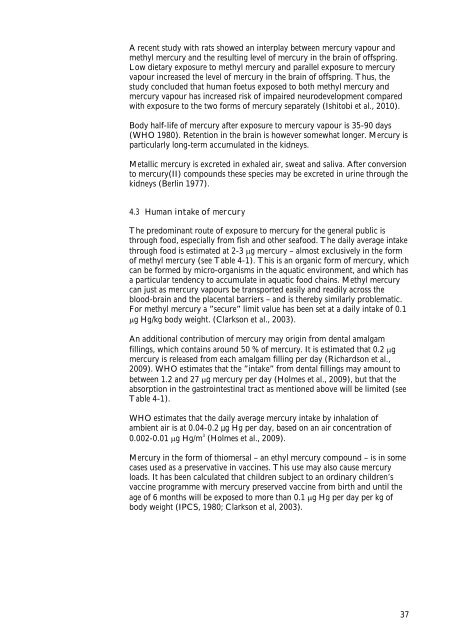No. 104 - Miljøstyrelsen
No. 104 - Miljøstyrelsen
No. 104 - Miljøstyrelsen
You also want an ePaper? Increase the reach of your titles
YUMPU automatically turns print PDFs into web optimized ePapers that Google loves.
A recent study with rats showed an interplay between mercury vapour and<br />
methyl mercury and the resulting level of mercury in the brain of offspring.<br />
Low dietary exposure to methyl mercury and parallel exposure to mercury<br />
vapour increased the level of mercury in the brain of offspring. Thus, the<br />
study concluded that human foetus exposed to both methyl mercury and<br />
mercury vapour has increased risk of impaired neurodevelopment compared<br />
with exposure to the two forms of mercury separately (Ishitobi et al., 2010).<br />
Body half-life of mercury after exposure to mercury vapour is 35-90 days<br />
(WHO 1980). Retention in the brain is however somewhat longer. Mercury is<br />
particularly long-term accumulated in the kidneys.<br />
Metallic mercury is excreted in exhaled air, sweat and saliva. After conversion<br />
to mercury(II) compounds these species may be excreted in urine through the<br />
kidneys (Berlin 1977).<br />
4.3 Human intake of mercury<br />
The predominant route of exposure to mercury for the general public is<br />
through food, especially from fish and other seafood. The daily average intake<br />
through food is estimated at 2-3 �g mercury – almost exclusively in the form<br />
of methyl mercury (see Table 4-1). This is an organic form of mercury, which<br />
can be formed by micro-organisms in the aquatic environment, and which has<br />
a particular tendency to accumulate in aquatic food chains. Methyl mercury<br />
can just as mercury vapours be transported easily and readily across the<br />
blood-brain and the placental barriers – and is thereby similarly problematic.<br />
For methyl mercury a ”secure” limit value has been set at a daily intake of 0.1<br />
�g Hg/kg body weight. (Clarkson et al., 2003).<br />
An additional contribution of mercury may origin from dental amalgam<br />
fillings, which contains around 50 % of mercury. It is estimated that 0.2 �g<br />
mercury is released from each amalgam filling per day (Richardson et al.,<br />
2009). WHO estimates that the ”intake” from dental fillings may amount to<br />
between 1.2 and 27 �g mercury per day (Holmes et al., 2009), but that the<br />
absorption in the gastrointestinal tract as mentioned above will be limited (see<br />
Table 4-1).<br />
WHO estimates that the daily average mercury intake by inhalation of<br />
ambient air is at 0.04-0.2 µg Hg per day, based on an air concentration of<br />
0.002-0.01 �g Hg/m 3<br />
(Holmes et al., 2009).<br />
Mercury in the form of thiomersal – an ethyl mercury compound – is in some<br />
cases used as a preservative in vaccines. This use may also cause mercury<br />
loads. It has been calculated that children subject to an ordinary children’s<br />
vaccine programme with mercury preserved vaccine from birth and until the<br />
age of 6 months will be exposed to more than 0.1 �g Hg per day per kg of<br />
body weight (IPCS, 1980; Clarkson et al, 2003).<br />
37

















